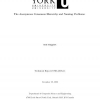OPODIS
2007
13 years 6 months ago
2007
Situation awareness is an important application category in cyber-physical systems, and distributed video-based surveillance is a good canonical example of this application class. ...
OPODIS
2007
13 years 6 months ago
2007
Abstract. We consider the distributed construction of a minimum weight 2edge-connected spanning subgraph (2-ECSS) of a given weighted or unweighted graph. A 2-ECSS of a graph is a ...
OPODIS
2007
13 years 6 months ago
2007
Abstract. In small-world networks, each peer is connected to its closest neighbors in the network topology, as well as to additional long-range contact(s), also called shortcut(s)....
OPODIS
2007
13 years 6 months ago
2007
OPODIS
2007
13 years 6 months ago
2007
We study private computations in a system of tiny mobile agents. We consider the mobile population protocol model of Angluin et al. [2] and ask what can be computed without ever re...
OPODIS
2007
13 years 6 months ago
2007
This paper tackles the consensus problem in asynchronous systems prone to byzantine failures. One way to circumvent the FLP impossibility result consists in adding synchrony assump...
OPODIS
2007
13 years 6 months ago
2007
OPODIS
2007
13 years 6 months ago
2007
Consider the following game between a worm and an alert3 over a network of n nodes. Initially, no nodes are infected or alerted and each node in the network is a special detector n...
OPODIS
2007
13 years 6 months ago
2007
Abstract. Grid monitoring systems collect a substantial amount of information on the infrastructure’s status in order to perform various tasks, more commonly to provide a better ...
OPODIS
2007
13 years 6 months ago
2007
Considering an asynchronous system made up of n processes and where up to t of them can crash, finding the weakest assumptions that such a system has to satisfy for a common leade...





